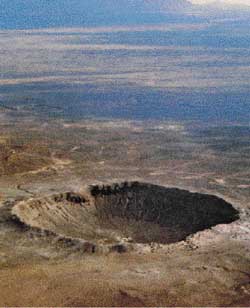heat into space instead of transferring it to the shuttle and its crew. That's the only safe way to dispose of what started as the shuttle's gravitational potential energy.
But even at its initial speed of 17,000 miles per hour, the shuttle's journey through the atmosphere is sluggish compared with that of visitors from deep space. When a comet  or asteroid or asteroid  approaches Earth, it falls from many millions of miles away. It converts enough of its potential energy into kinetic energy to strike the atmosphere at speeds of up to 50,000 miles per hour. That's dozens of times faster than a supersonic plane approaches Earth, it falls from many millions of miles away. It converts enough of its potential energy into kinetic energy to strike the atmosphere at speeds of up to 50,000 miles per hour. That's dozens of times faster than a supersonic plane  . Past encounters between Earth and interlopers from space have revealed the different ways in which such releases of energy can affect our planet. . Past encounters between Earth and interlopers from space have revealed the different ways in which such releases of energy can affect our planet.
On the night of June 30, 1908, a seismograph in Irkutsk, Russia, recorded what resembled a distant earthquake. A thousand miles away, villagers near the Tunguska  River in Siberia witnessed a fireball streaking through the sky, a burst of light, a thunderous sound, and an enormous blast. Scientists finally ventured to the remote site in 1927 to find nearly 1,000 square miles of burned and flattened forest River in Siberia witnessed a fireball streaking through the sky, a burst of light, a thunderous sound, and an enormous blast. Scientists finally ventured to the remote site in 1927 to find nearly 1,000 square miles of burned and flattened forest  . Modern impact analysis suggests that a rocky asteroid . Modern impact analysis suggests that a rocky asteroid  or the core of a small comet or the core of a small comet  , about 200 feet across, knifed into the atmosphere at a shallow angle and exploded several miles above the surface. The object's kinetic energy converted almost completely into heat, reducing it to dust. The explosion's power was easily a thousand times greater than that of the bomb dropped on Hiroshima , about 200 feet across, knifed into the atmosphere at a shallow angle and exploded several miles above the surface. The object's kinetic energy converted almost completely into heat, reducing it to dust. The explosion's power was easily a thousand times greater than that of the bomb dropped on Hiroshima  . Had it struck over an urban part of the world, everyone in an area the size of New York City would have died instantly. . Had it struck over an urban part of the world, everyone in an area the size of New York City would have died instantly.
An asteroid  of similar size struck an uninhabited sandstone plateau 50,000 years ago in what is now northern Arizona in north central Arizona. of similar size struck an uninhabited sandstone plateau 50,000 years ago in what is now northern Arizona in north central Arizona. . That object, a solid mixture of iron and nickel, was denser than the Tunguska . That object, a solid mixture of iron and nickel, was denser than the Tunguska  impactor. Much of the asteroid impactor. Much of the asteroid  melted as it screamed through the atmosphere. The molten storm spread into a fiery plume over the Four Corners region where Arizona, Colorado, New Mexico, and Utah now meet. The rest of the asteroid melted as it screamed through the atmosphere. The molten storm spread into a fiery plume over the Four Corners region where Arizona, Colorado, New Mexico, and Utah now meet. The rest of the asteroid  melted on impact and gouged a circular scar nearly a mile wide and almost 600 feet deep. The rim of this scar, called Meteor Crater melted on impact and gouged a circular scar nearly a mile wide and almost 600 feet deep. The rim of this scar, called Meteor Crater  , stands 15 stories above the surrounding land--a raised "lip" similar to the one you can produce by spiking a volleyball into sand. Such impacts were common billions of years ago when the solar system was young and crowded with debris, but they are rare today. Even (continued) , stands 15 stories above the surrounding land--a raised "lip" similar to the one you can produce by spiking a volleyball into sand. Such impacts were common billions of years ago when the solar system was young and crowded with debris, but they are rare today. Even (continued)
|


